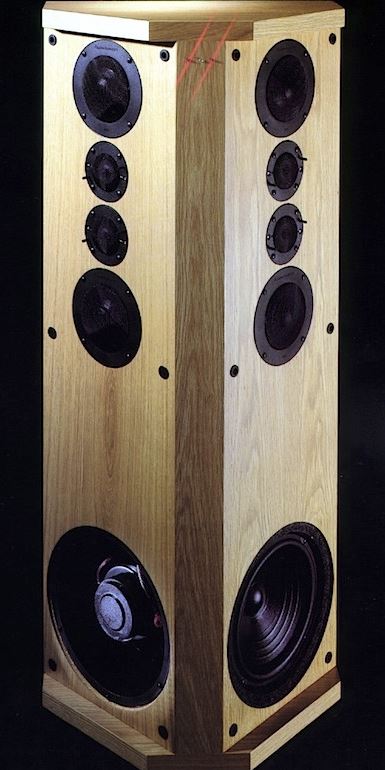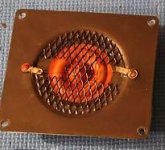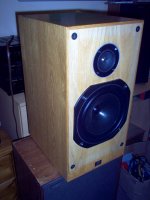I wanna do a MMTTMM, using two dome tweeters (Accuton diamond too expensive), maybe it's not necessary.....?
Unless you want wide horizontal and narrow vertical dispersion in the treble, other than power handling, I don't see an advantage. A ribbon can give you similar dispersion. A waveguide could give you similar dispersion, but with horizontal that matches your woofer's directivity at the crossover point. If your reason is aesthetics, then you may not realize what you are getting into.
As already mentioned the benefit of the taller tweeter is to reduce ceiling reflections. The tweeters whould work together but separate domes will only work together productively in some ways. The interaction is not ideal. 45cm spacing will give you narrow lobes that will be difficult to make useful.
The fact that their interference is only partially constructive will limit the increase in sensitivity replacing it with a complex interaction.
It would be much easier to put some absorption on the ceiling IMO.
The fact that their interference is only partially constructive will limit the increase in sensitivity replacing it with a complex interaction.
It would be much easier to put some absorption on the ceiling IMO.
The Allison IC20 design is clever. It's really a WMTTMW near the floor. The crossover and layout is arranged so the Allison Effect of cancellation with the floor and wall, via delayed images, is bypassed because you crossover below the point where the effect kicks in.

I don't know if it's BW3 or Linkwitz-Riley LR2 or LR4, which is another issue on general dispersion.
For sure, the room plays havoc with bass. But what I like about MTTM concept, is they don't get ear-bleedingly loud when you stand close to them. Because the +6db loudness comes from two individually quieter drivers. The PA reinforcement concept.

I don't know if it's BW3 or Linkwitz-Riley LR2 or LR4, which is another issue on general dispersion.
For sure, the room plays havoc with bass. But what I like about MTTM concept, is they don't get ear-bleedingly loud when you stand close to them. Because the +6db loudness comes from two individually quieter drivers. The PA reinforcement concept.
Last edited:
When I was at Bell Labs decades ago, a group of us wanted to buy good tweeters. So we gathered a bunch and tested them in the big anechoic chamber (a main criterion was tone bursts - not the Hamm-windows of REW).
A fabric fried egg with "Magnavox" printed on the back was the clear winner. We bought a large case from a store on old Route 22. I took 18 (for stereo) and made a half-a-hexagon in cross-section open-backed stand, wired (obviously) in series-parallel (now a days, anybody with good sense uses electronic crossovers). Absolutely wonderful room filling treble (best rebel I had until I started making electrostatic panels).
I think a lot of theory doesn't work well with tweeters in rooms playing music. I offer this experience:
1. ability to handle power output matters more than you'd expect in tweeters
2. fussing about phase arithmetic is just not meaningful; applies when you are working with microphones but not with ears
3. thinking through issues of psychoacoustics and speakers-in-rooms is crucial and mightily influences the sound of music.
Ben
A fabric fried egg with "Magnavox" printed on the back was the clear winner. We bought a large case from a store on old Route 22. I took 18 (for stereo) and made a half-a-hexagon in cross-section open-backed stand, wired (obviously) in series-parallel (now a days, anybody with good sense uses electronic crossovers). Absolutely wonderful room filling treble (best rebel I had until I started making electrostatic panels).
I think a lot of theory doesn't work well with tweeters in rooms playing music. I offer this experience:
1. ability to handle power output matters more than you'd expect in tweeters
2. fussing about phase arithmetic is just not meaningful; applies when you are working with microphones but not with ears
3. thinking through issues of psychoacoustics and speakers-in-rooms is crucial and mightily influences the sound of music.
Ben
Last edited:
TBH, Bentoronto, we should separate the MTTM concept from tweeter quality. Because T doesn't say a lot about it. Separation of variables and all that. 🙂
Doubtless, cones and ring-radiators and even metal tweeters (with a Zobel) work better than soft domes. Why? Because soft domes break up horribly in the middle of the dome.
The fried egg tweeter in Advent designs was a decent idea, below. I incline to cone tweeter still. We take our beating on dispersion, but musical to the max. Cheap too. It's what I listen to.
Doubtless, cones and ring-radiators and even metal tweeters (with a Zobel) work better than soft domes. Why? Because soft domes break up horribly in the middle of the dome.
The fried egg tweeter in Advent designs was a decent idea, below. I incline to cone tweeter still. We take our beating on dispersion, but musical to the max. Cheap too. It's what I listen to.
Attachments
- Status
- Not open for further replies.

